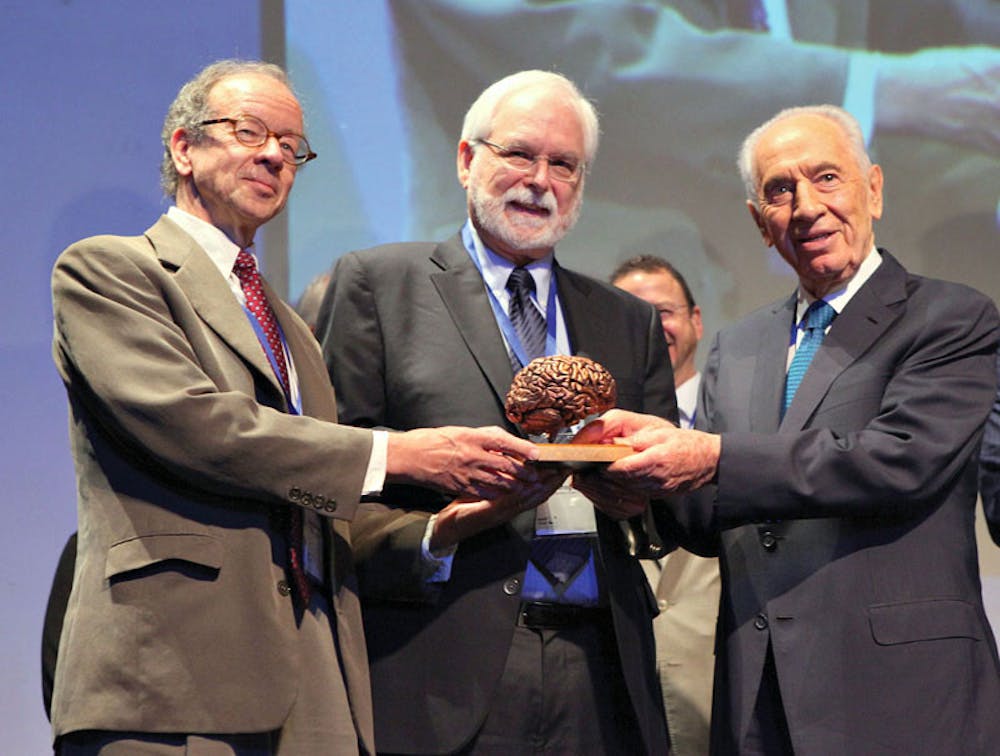The $1 million Moshe Mirilashvili Memorial Fund Breakthrough Research and Innovation in Neurotechnology Prize was awarded to BrainGate researchers for their creation of a brain-computer interface that could aid people with paralysis. Israeli President Shimon Peres presented the award to Professor of Neuroscience John Donoghue PhD ’79 and Professor of Engineering Arto Nurmikko at a technology conference Oct. 15 in Tel Aviv.
The interface is composed of a small patch of electrodes that receives and transmits neural signals to a computer that interprets patterns and sends commands to operative assistive devices. Most famously, in May 2012, the team released a video of a woman with severe paralysis grabbing and drinking from a bottle with a robotic arm simply by thinking about moving her arm.
BrainGate is a “team of physicians, scientists and engineers working together to study the brain and develop neurotechnologies for people with neurologic disease, injury, or limb loss,” according to the group’s website. While based at Brown, the team also collaborates with the Providence Department of Veterans Affairs, Massachusetts General Hospital, Stanford University and Case Western Reserve University.
The prize came as a surprise to the researchers, Donoghue said. He recalled his disbelief just before Peres announced the winners.
“Just then I said, ‘What if he says it’s us?’” Donoghue said.
The prize money will help ease the burden of cost associated with the interface development.
“Medical devices cost $100, $150 million to develop, so this is a very important piece to help accelerate that development,” Donoghue said.
Fellow team members expressed similar excitement about the award.
“I’m extremely happy for John and Arto. … This is a remarkable project spanning many years, and it promises to advance our understanding of the brain while bringing new therapies to people with impaired movement,” wrote Michael Black, professor of computer science, in an email to The Herald. Black contributed to the project by decoding the neural signals.
In February 2013, the team revealed a wireless version of the interface that would grant users greater mobility and freedom. The team hopes to eventually create a version of the device that is fully implantable in a human body, Donoghue said.
“Our goal is to take the whole cart of electronics and put it inside of something the size of a smartphone. … We want to see this through so that it actually gets out to help people in the real world,” Donoghue said.
The brain-computer interface can also be used to study brain activity “at a level that’s never been done before,” said Donoghue.
The interface may eventually be used to detect potential seizures before they occur. The implanted device would warn the patient of an oncoming seizure and then automatically inject him or her with a drug that would prevent the seizure. This treatment could be applied to depression and other psychiatric disorders, Donoghue said.
Though the award specifically recognized Donoghue, Nurmikko and Leigh Hochberg ’90, associate professor of engineering, as world leaders in the development of neurotechnology, BrainGate is a collaboration among many more faculty members and students, Donoghue said.
“The prize recognizes the collection of an extraordinary group of Brown University scientists across multiple disciplines which I have been privileged to be associated with,” Nurmikko said in an Oct. 15 University press release. “We work as a team unlike any other place I know.”

ADVERTISEMENT




